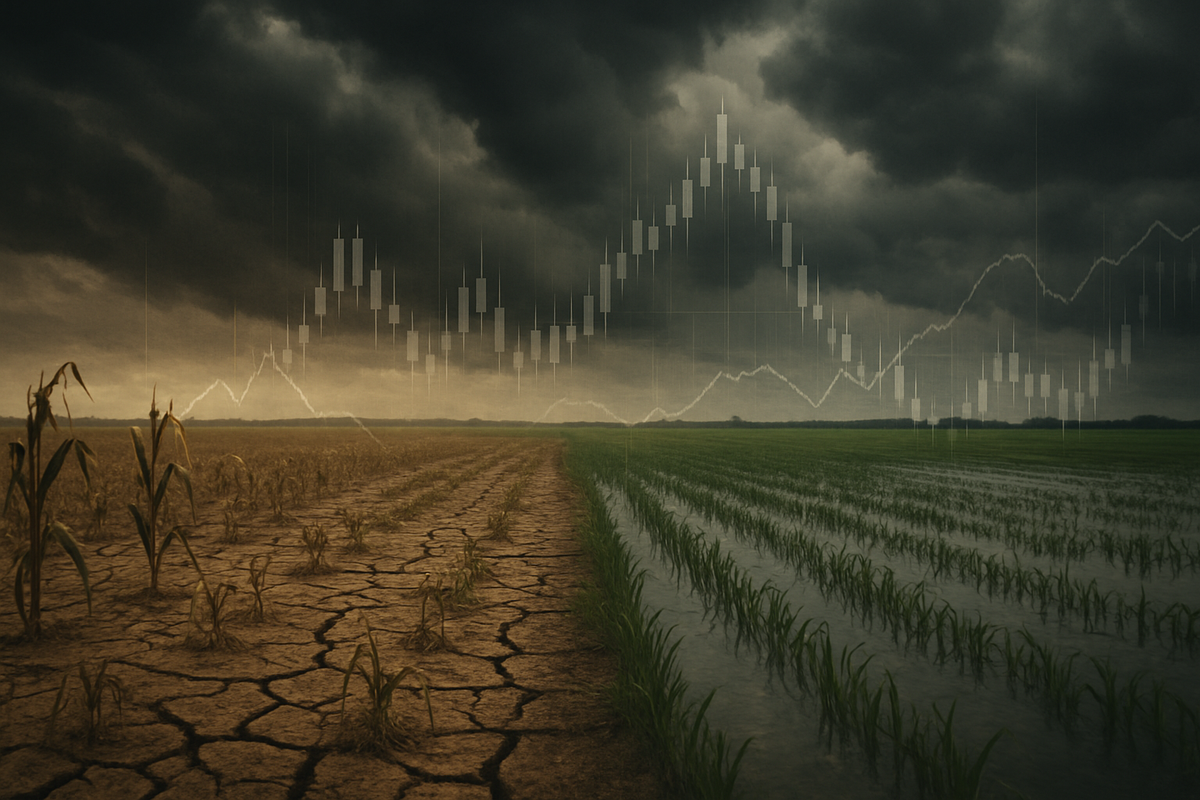Climate's Grip Tightens: Agricultural Commodities Face Unprecedented Volatility
By:
MarketMinute
September 30, 2025 at 17:00 PM EDT

As of late September 2025, the global agricultural commodity market finds itself in an increasingly turbulent state, grappling with the intensifying and unpredictable forces of climate change. Extreme weather events, ranging from searing droughts to catastrophic floods, are not merely isolated incidents but persistent threats that are fundamentally reshaping global food systems. This escalating volatility is driving up food prices, threatening food security for millions, and creating a complex, high-stakes environment for investors and public companies alike. The immediate implications are clear: a future where the stability of our food supply is increasingly contingent on our capacity to adapt to a rapidly changing climate. A Year of Extremes: Climate Shocks Reshape Agricultural LandscapesThe period spanning 2024 and 2025 has been marked by a relentless series of climate-induced disruptions that have sent shockwaves through agricultural production worldwide. These events have not only slashed yields but have also ignited significant price surges across key commodities. Specific Details and Timeline of Disruptions:
Initial Market Reactions and Key Players: These climate-driven impacts translated directly into significant commodity price fluctuations. Cocoa prices globally hit record highs in February 2024, doubling since early 2023, largely due to dry weather and heavy rains in West Africa. Coffee prices also soared by 103% due to adverse conditions in Brazil and Vietnam. Olive oil, corn, wheat, rice, sunflower oil, and beef all saw substantial price increases. While some commodities, like US corn and soybeans, have seen price stabilization or even declines due to abundant harvests in other regions, overall market sentiment remains one of heightened volatility. Key players grappling with these dynamics include major producing nations (U.S., Brazil, West Africa, Europe, India, China, Australia), government agencies like the U.S. Department of Agriculture (USDA), and large agricultural businesses such as Archer-Daniels-Midland Co. (NYSE: ADM). A significant market reaction has been the surge in investment and interest in climate-smart agriculture, with the global market projected to reach $200 billion by 2030, highlighting both the necessity and economic opportunities in this evolving sector. Corporate Crossroads: Winners and Losers in a Changing ClimateThe escalating volatility in agricultural commodities is creating a distinct divide among public companies, rewarding those that innovate and adapt, and penalizing those that remain tied to traditional, climate-vulnerable models. Companies Facing Significant Risks and Potential Losses:
Companies Poised for Growth and Resilience:
The Broader Tapestry: Industry Shifts, Policy Imperatives, and Historical EchoesThe impact of climate change on agricultural commodities extends far beyond individual farms or companies, weaving into broader industry trends, creating ripple effects across entire supply chains, prompting new regulatory frameworks, and drawing comparisons to historical agricultural challenges. Broader Industry Trends: Decreased crop yields are becoming a norm in many regions. A June 2025 study highlighted that global caloric yields from staple crops could be 24% lower by 2100 without climate action. This decline, coupled with increased price volatility, is driving a rapid emergence of "climate-smart food" initiatives aimed at boosting productivity, enhancing resilience, and reducing emissions. The widespread adoption of climate-smart agricultural (CSA) practices, including innovative soil management and drought-resistant crop varieties, is influencing supply, demand, and pricing globally. Disruptions to supply chains and logistics, such as low water levels in major waterways like the Mississippi River, are forcing producers and shippers to rethink how crops reach the global market, adding to costs and instability. Ripple Effects on Competitors and Partners: This climate-driven transformation creates competitive advantages for early adopters of climate-smart practices, potentially leading to a two-tiered agricultural market. Deep collaboration across the food supply chain, from farmers to retailers, is becoming essential. Food and beverage companies are increasingly engaging with agricultural suppliers through financial incentives and technical assistance to reduce Scope 3 emissions and ensure supply chain resilience. The distress among crop producers also affects agricultural input providers, while livestock producers face both opportunities (lower feed prices in some cases) and challenges (increased feed costs and heat stress impacts on animals). Climate change also acts as a "force multiplier" for food insecurity, exacerbating geopolitical tensions through export restrictions on staple crops, as seen with rice and wheat in 2024-2025. Regulatory and Policy Implications: Governments and international bodies are actively shaping the policy landscape. The U.S. Farm Bill, due for a rewrite in 2025, is a critical instrument for allocating funds towards climate-smart agriculture. The U.S. Environmental Protection Agency (EPA) is undergoing significant regulatory changes in 2025, balancing environmental stewardship with economic growth. Internationally, policies promoting environmental practices like agroforestry and organic farming affect supply and pricing. A notable example is the EU Deforestation Regulation (EUDR), which by December 2025 requires companies importing commodities like beef, cocoa, and palm oil into the EU to declare their products deforestation-free, potentially impacting exports from high-risk countries. Governments are also exploring climate disclosure requirements for corporations and innovative funding mechanisms, such as "climate superfunds," to support farmers. Historical Precedents: While the scale and human-driven nature of current climate change are unprecedented, historical events offer some parallels. Ancient agricultural practices themselves altered Earth's climate, demonstrating humanity's long-standing influence. Historically, agricultural markets have always been susceptible to weather volatility, with past negative weather shocks leading to higher prices. However, modern technological advancements and economic adaptations have changed the system's sensitivity. The "Green Revolution" and the organic food movement serve as precedents for how consumer and regulatory pressures can rapidly transform segments of the food industry, suggesting a similar trajectory for climate-smart foods. The Path Forward: Adaptation, Innovation, and ResilienceLooking beyond September 2025, the agricultural commodity sector faces a future defined by the imperative to adapt and innovate. Both short-term adjustments and long-term systemic transformations will be necessary to ensure global food security and market stability. Short-Term Possibilities (2025-2030): Continued volatility is expected, driven by intensified extreme weather and fluctuating input costs. Crops like cocoa, coffee, rice, maize, and wheat remain particularly vulnerable. However, strategic pivots are already underway. Enhanced early warning systems, research into drought- and pest-resistant crops, and widespread adoption of sustainable practices like conservation tillage and crop rotation are becoming crucial. Precision agriculture technologies, such as GPS-guided tractors and soil moisture sensors, will optimize resource use. Policy support, like the USDA's Partnerships for Climate-Smart Commodities initiative, will be vital in building resilience and fostering new markets. Long-Term Outlook (Beyond 2030): The long-term outlook points to more profound shifts, including altered agricultural zones, potential yield decreases for staple crops (e.g., maize yields potentially down 24% by 2030), and increased water scarcity. The global demand for food is projected to continue rising, potentially requiring production to almost double by 2050, further exacerbating commodity price hikes (10-40% higher by 2050 across various scenarios). The widespread adoption of Climate-Smart Agriculture (CSA) practices, coupled with continuous technological innovation in crop breeding and water management systems, is indispensable. Policy and trade mechanisms will play a critical adaptive role, allowing countries to address food shortages and specialize in resilient production. Dietary shifts towards plant-based proteins are also anticipated, creating new market opportunities. Market Opportunities and Challenges: Opportunities abound in the rapidly growing market for climate-smart agricultural products, projected to reach $200 billion by 2030. Ecosystem services, such as carbon sequestration, could provide additional revenue streams for farmers. The sustainable food industry is driving demand for farmers who can meet rigorous environmental standards. Conversely, challenges include persistent price volatility, heightened food security concerns, higher production costs due to climate transitions, and potential trade disruptions. Small-scale farmers, particularly in low-latitude regions, remain highly vulnerable. Potential Scenarios:
A Pivotal Juncture: Investing in a Resilient FutureThe agricultural commodity market stands at a pivotal juncture. While inherent volatility remains a challenge, the accelerating adoption of climate-smart initiatives and increasing investment in resilient food systems offer pathways towards a more stable and sustainable future. The economic costs of inaction far outweigh the investments required for adaptation and mitigation. Key Takeaways for Investors: The global food system is undergoing a fundamental transformation driven by climate change, necessitating a proactive and adaptive approach from all stakeholders. The increasing financial commitment to climate finance for agriculture, exemplified by the World Bank's increased lending and the projected $200 billion climate-smart agriculture market by 2030, underscores the profound economic significance of this shift. What Investors Should Watch For in Coming Months:
Investors who recognize these evolving dynamics and strategically position themselves in companies and solutions driving climate resilience will be best equipped to navigate the complexities and capitalize on emerging opportunities in the agricultural sector. This content is intended for informational purposes only and is not financial advice More NewsView More
Why Gold Loves Trump as Much as Trump Loves Gold ↗
Today 18:35 EST


Palantir Isn’t Just Riding the AI Boom—It’s Orchestrating It ↗
Today 16:38 EST

Insiders Are Snapping Up This AI Stock—Is a Big Bounce Coming? ↗
Today 15:29 EST

Via MarketBeat
Recent QuotesView More
Stock Quote API & Stock News API supplied by www.cloudquote.io
Quotes delayed at least 20 minutes. By accessing this page, you agree to the Privacy Policy and Terms Of Service.
© 2025 FinancialContent. All rights reserved.
|